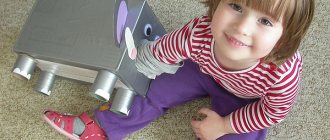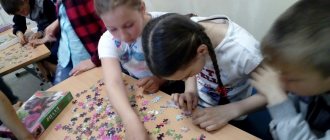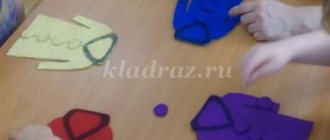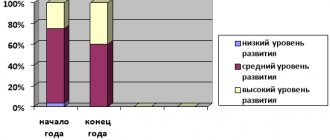Card index of games for the development of fine motor skills in the younger group
Victoria Kuleshova
Card index of games for the development of fine motor skills in the younger group
"Watchmaker"
Objectives: ability to use tweezers to move objects. Development of fine finger movements, coordination of movements, preparation of the hand for writing.
Material: platform with cells for beads, tweezers, cup with beads.
Progress of the game: the child places in front of him a small tray on which there is a platform with cells for beads, tweezers and a cup with beads. He picks up tweezers and, carefully grasping the bead with its ends, puts it in the cell. So gradually he transfers all the beads from the cup to the platform.
This exercise is especially good for training finger coordination. It requires extreme concentration. Please note that the material has internal control. If a child clumsily worked with tweezers and a bead fell onto the tray, he can always see it and correct the mistake. The work requires great precision in movements.
"Beads for a doll"
Objectives: development of fine motor skills , coordination of movements, learning the ability to distinguish objects by shape and color, training concentration.
Material: thread, buttons of different sizes and colors, beads as a sample.
How to play: Invite the child to make the beads himself. To do this, he must string buttons on one thread. You can make beads using an existing sample or select buttons according to the shape and color according to your specifications.
"Colored Drops"
Objectives: development of finger movements, concentration, coordination of movements, preparation of the hand for writing. This game also allows the child to practice matching and distinguishing colors.
Material: ice tray with cells. Mark the first cells with a red felt-tip pen. The second cells are blue, and the last ones are yellow. Three bubbles - with water of their own color. Three pipettes with tight rubber caps that must be inserted into the vials. Little sponge.
Progress of the game: The child brings the material to the work table and begins to transfer water drop by drop from the bubbles to the cells of the platform, gradually filling them with water. He then uses pipettes to transfer the water back into the bubbles. After finishing the game, the child must use a sponge to collect the accidentally spilled water and clean up everything else.
"The Horse's Mane"
Tasks: development of hand muscles , activation of the speech center of the brain, preparation for fastening buttons, tying shoelaces.
Material: basket with trailers, horse models.
Progress of the game: The child takes a basket with trailers and places it on the work table. The teacher says: “Soon there will be a holiday where horses will perform, we need to decorate the mane beautifully.” The child independently picks up the clothespins with three fingers and decorates the horse’s mane. The next task is to decorate by alternating clothespins by color. After playing, the child puts everything back in its place on his own.
"Embroiderers"
Objectives: development of fine motor skills , precise movements of fingers, coordination of movements and concentration.
Material: tray, a sheet of cardboard with holes made, one or two needles, a ball of woolen thread.
Progress of the game: in front of the child lies a sheet of cardboard with holes made. Then the teacher shows the child how to embroider on cardboard . Working with a needle, especially threading a needle and tying a knot, is very difficult for a small child, so at first it is better to simply show and perform these operations together with the child, hand in hand, with patience and precision to catch the moment when the child’s hand can be released and invite him to act independently. You can observe the baby’s high concentration, a high degree of concentration. The baby trains the coordination of small movements of the fingers , the accuracy of the eye and the sequence of movements.
"Lace up your shoe"
Objectives: development of fine motor skills , coordination of movements, learning the ability to put on shoes, navigate in space.
Material: a pair of boots or sneakers and laces for them.
How to play: Show your child how you can lace a shoe or sneaker in different ways. Lace it in one of the following ways and ask your child to lace the second shoe or sneaker in the same way.
Important!
First, lace up your child's shoes.
"Collect a matryoshka doll"
Objectives: learn to perform simple actions with objects of varying sizes, develop hand motor skills and coordination of movements.
Description of the game.
The teacher shows the matryoshka doll, shaking it slightly. Something is rattling inside her. The teacher opens the matryoshka doll and takes out the insert. He puts both nesting dolls next to each other and says: “The dolls are beautiful, but they are different - big and small.”
Taking out another nesting doll, the teacher arranges all three objects in one row and emphasizes the difference in size. Children look at the nesting dolls.
Then the teacher assembles the nesting doll in reverse order: the small one hides in the middle one. Then the teacher opens the large matryoshka doll and hides the middle one in it.
After the preliminary screening, children are given individual material for independent work.
"Pyramid"
Objectives: generalization of sensory experience, development of coordination of hand movements under the control of vision and touch.
Description of the game.
Show the child the pyramid, let him touch it so that the child can see: the rings differ from each other in their sizes. Then invite the child to remove the rings from the pyramid. The teacher draws the children's attention to the fact that the rings on the pyramid are different. Accompanying the removal of each ring with words. At the same time, show how to take the rings with the fingers of both hands.
On the table, all the rings are laid out evenly, in increasing sizes to the right of the pyramid. Then the pyramid is assembled in the appropriate order.
"Search for objects in a bowl of cereal"
small toys hidden in it . This is beneficial for their psyche, the kids calm down, focus on finding surprises and learn to concentrate and be careful. Develop tactile senses of the fingertips.
Material: A deep, stable bowl filled with some kind of cereal; several small objects - toys, pebbles 9 objects must be changed periodically to maintain the child’s interest and curiosity).
Description of the game.
The teacher and the child bring the material to the table. We immerse our hands in the cereal and encourage the baby to do the same. "Suddenly"
We find the hidden object and put it on the table. We ask the child to find the rest of the hidden objects. We show how you can hide an object back into the cereal by burying it. We focus the child's attention on special care - there should be no cereals on the table. If suddenly some of the cereal accidentally spills, you need to remove it with a table brush.
"Tying and Untying Bows "
A classic exercise by Maria Montessori, the direct goal of which is to master the ability to tie and untie shoelaces and bows . At the same time, the child learns precise finger movements, sequence of operations and is focused on each step of the work. In this context, tying and untying frames , as well as fastening buttons and buckles, indirectly prepare the child for mastering the writing process.
Material A wooden frame on which two halves of fabric are attached, connected by red and white bows. There are five bows in total.
How to work with the material.
Untying . The child begins to untie the top bow and always works from top to bottom. He takes the ends of the ribbon with both hands and stretches them to the sides. The top bow, and behind it all the others, are untied . Now we will pry up the knots with our index finger, starting from the top one, and moving forward we untie them too . We straighten the ends of the ribbon to the sides and fold back the halves of the fabric to mark that the bows and knots are completely untied .
Tying. Connect the halves of the fabric to the center. Let's take the ends of the top braid and throw them in opposite directions. Index finger
Using your left hand, move the tape and form a large loop from it. With your right hand, wrap the other end of the tape around this loop clockwise and insert it into the hole. Stretch the ends of the tape to the sides. The knot is tied. We will also tie the remaining knots, moving from top to bottom. Now let's start tying the bows. We will do exactly the same as with knots, but we will make narrow loops from the ends of the ribbon, gathered towards the base of the bow. In this case, the second loop is carefully pulled out from under the first and the bow itself is aligned.
"Coil"
Objectives: learn to wind thread on a spool. Develop coordination of small movements of the hand , concentration, development of independence , sequence of movements, preparing the hand for writing.
(or thick thread) wound on it
.There can be 2-3 coils
(of different sizes)
for gripping with the entire palm or three leading fingers.
Description of the game.
The teacher and the child bring a basket of spools to the table. The teacher invites the child to first unwind the thread from the spool. Hold the spool with your right hand by the round part, and use your left hand to unwind the thread in a circular motion away from you. Next, the child unwinds the thread himself. Then he offers to wind the thread onto the spool in the same way, but making circular movements with his left hand in the opposite direction (towards himself)
. A neatly wound thread indicates a job well done.
Exercises.
After children have mastered the process of winding thread onto spools, you can offer to wind the thread into small multi-colored balls.
"Paper Clips"
Objectives: learn to use paper clips correctly. Develop fine motor skills , coordination of movements, prepare the hand for writing, develop fantasy and imagination.
Material: in a flat basket there are: a cardboard circle (or other shapes, covered with colored paper, paper clips of different colors and sizes in a small box.
Description of the game.
The teacher and the child bring a basket of materials to the table. An adult takes a circle with three fingers of his left hand, and a paper clip with three fingers of his right hand. Places a paper clip on the circle so that it is on the front and back sides at the same time (as sheets of paper are fastened together)
. Next, the child continues to work independently, combining the color of the paper clips, their size, creating patterns and ornaments around the circumference.
Exercises
You can invite your child to fasten several sheets of paper with a paper clip.
"Scroll"
Objectives: be able to use hair ties. Develop fine motor skills and coordination of movements. Concentration, ability to take care of yourself.
Material: a small basket containing a cardboard cylinder , about 5 cm in diameter, 5-6 hair ties, different colors.
Description of the game.
The teacher and the child bring the basket to the table. The teacher takes the three main fingers of his right hand and pulls out an elastic band. With the help of his left hand, he threads the leading fingers of his right hand into the elastic band and spreads his fingers slightly to the sides - the elastic band is stretched. Then he takes the cylinder out of the basket with his left hand and holds it horizontally by the middle. He wraps the fingers of his right hand around the cylinder and puts an elastic band on it. He places the cylinder in front of him. The teacher repeats the show 1-2 more times. Then the child works independently. To remove the elastic bands, roll them one at a time onto the edge of the cylinder with the fingers of your right hand, holding the cylinder itself in your left hand.
"Salty dough"
Objectives: develop concentration , master the sequence of actions, develop fantasy and imagination, develop fine motor skills of the hand , develop the eye .
Materials: cutting boards, small rolling pin, flat culinary molds, sponge.
Description of work.
There are cutting boards on the table in front of each child. Each child is given a piece of dough. A child can knead, tear, and roll out the dough.
You can give each child a stencil mold. Children use it to squeeze out shapes in the dough; the excess dough is pushed to the edge of the board. Take the figurine out of the mold, and dry the resulting figurine in a separate place. The remaining dough is rolled out again and the figures continue to be made until the dough is finished. You can simply do any crafts according to the teacher’s instructions without molds.
"Game with Soap Bubbles"
Objectives: the child learns to make a soap mixture and blow soap bubbles. Develop independence , concentration, accuracy of movements and correctness in the sequence of actions.
Materials: a tray with a small bowl on it, a grater, a small spoon, disposable juice straws, a sponge for wiping up spilled water.
Description of the game.
Children and the teacher bring the material to the table. We take the soap out of the soap dish and grate it a little, then put the soap back into the soap dish. Using a spoon, transfer the soap powder into a bowl. Pour water into a glass and add water to the soap powder. Stir the mixture with a spoon until the soap crumbs are completely dissolved in the water. We take out a disposable straw from the package and, lowering one end completely into the bowl, blow (carefully: inhale through the nose and exhale through the straw through the mouth)
.
Watch the formation of beautiful soap bubbles. We draw the children’s attention to the fact that the bubbles should not “run away”
from the bowl; when there are already a lot of bubbles, we take out the tube and simply blow air on the bubbles. They're bursting! At the end of the game, the bowl is washed under the tap and the straw is thrown away.
Didactic game as a means of developing fine motor skills in preschool children
Didactic game as a means of developing fine motor skills in preschool children.
The problem of developing fine motor skills is relevant because... children have developmental problems. For children with speech pathology, finger movements pose considerable difficulty, because fine motor skills are closely related to speech function. A stimulating effect of hand function on the development of mental functions and brain activity in general was noted. It is also well known that in the process of child growth, the development of fine motor skills of the hands is very important. This is facilitating motor coordination, overcoming tightness and stiffness.
Exercises developed by domestic and foreign researchers make it possible to combine the development of fine motor skills with various speech tasks. Many scientists, teachers, and psychologists have developed games that make it possible to organically combine finger movements with exercises in differentiating sounds.
It is known that play is the main activity of a preschooler, and among the toys children most love are those that stimulate their own activity: motor, construction, social. Play is the most important means of a child’s mental development.
The importance of the development of fine motor skills in the process of forming a child’s cognitive mental processes.
In the process of acting with objects, children begin to develop fine manual motor skills from infancy. It is closely related to the physiological and mental development of the child.
Grasping movements appear first. The child grabs objects hanging above the crib and gradually learns to act purposefully, correctly determine the object’s place in space (direction and distance), and take into account the shape and size of objects in his actions. That. he develops perception and hand-eye coordination.
In the development of fine motor skills in young children, correlating actions play an important role, i.e. such actions when you need to combine two objects or two parts of an object. The principle of correlating actions underlies the game tasks of many didactic toys (turrets, nesting dolls, pyramids, etc.) By playing with them, the child improves manual dexterity, eye, and coordination of hand actions.
It is necessary to begin work on the development of fine motor skills from a very early age. Already in infancy, you can massage your fingers, thereby influencing active points associated with the cerebral cortex. The development of manipulations with objects at a very early age has a positive effect on the formation of cognitive mental processes: perception, memory, thinking, attention, imagination, as well as the development of speech.
Game as a form of organizing the life and activities of children.
Play is the main activity of children. With the power of imagination, playful actions, roles, and the ability to transform into an image, children create a game.
Children do not set any goals in the game other than the goal of playing. In play, children reflect the life around them and learn certain facts and phenomena that are accessible to their perception and understanding. But children of even older preschool age perceive only external aspects and are less able to assimilate the reasons for the connection.
Using the game as a means of familiarizing themselves with the world around them, the teacher has the opportunity to direct children’s attention to those phenomena that are valuable for expanding the range of ideas. And at the same time, it nourishes children’s interest in developing curiosity, the need and awareness of the need for assimilation to enrich the content of the game, and through the game, in the process of playing, it forms the ability to manage knowledge in various conditions. By directing the game, the teacher fosters an active desire in children to learn something, search, show effort and find, enriches the spiritual world of children. And all this contributes to mental and general development.
Thus, the teacher, organizing the life and activities of children in the game, consistently develops activity and initiative, and develops self-organization skills in the game.
The concept of a didactic game.
In pedagogy and psychology there are different understandings of didactic games. It is considered from the following positions:
- as an activity, the meaning and purpose of which is to give children certain knowledge and skills; as a game designed for learning;
- as a game that has a didactic goal and requires appropriate didactic material;
- as a process of using didactic material in gaming activities, through which a learning effect is produced that promotes the development of abilities and knowledge;
- as a unified system of influences aimed at developing the need for knowledge, active interest in what may be their new source, as well as more advanced cognitive skills and abilities: sensory, intellectual;
- as a series of preparatory operations included in the game task.
Despite some differences, all these approaches have common points.
It is generally accepted that a didactic game, firstly, has a didactic goal, which is included in the gaming activity and combined with the gaming task. Secondly, it involves the use of didactic material. It must be emphasized that such a game is created by an adult. The child receives it ready-made.
Based on the above, we can propose the following definition of a didactic game: it is a game created by an adult for didactic purposes, which are solved on the basis of the interaction of gaming and didactic tasks.
Types of didactic games.
- Playing with objects or toys. Aimed at developing tactile sensations, the ability to manipulate various objects and toys, developing creative thinking and imagination.
- Word games. For the development of auditory memory, attention, communication abilities, as well as for the development of coherent and dialogical speech, the ability and desire to express one’s thoughts.
- Desktop-printed. Used as a visual aid aimed at developing visual memory and attention.








